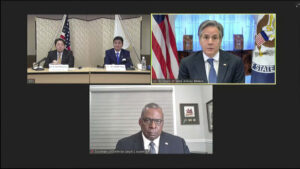
The U.S. and Japan are working on signing a new five-year deal to continue sharing the cost for the American military presence in Japan as well as a new research and development agreement to collaborate on emerging technologies, U.S. Secretary of State Antony Blinken said Thursday. Blinken delivered the announcement during a virtual meeting with Defense Secretary Lloyd Austin and Japanese Foreign Minister Hayashi Yoshimasa and Defense Minister Kishi Nobuo, where the leaders cited their concerns with growing challenges from…

 By
By 











